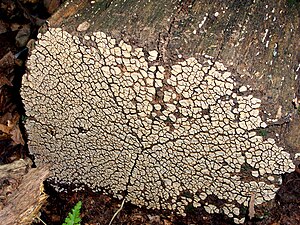Mosaic layer mushrooms
| Mosaic layer mushrooms | ||||||||||||
|---|---|---|---|---|---|---|---|---|---|---|---|---|

Mosaic layer mushrooms ( Xylobolus ) |
||||||||||||
| Systematics | ||||||||||||
|
||||||||||||
| Scientific name | ||||||||||||
| Xylobolus | ||||||||||||
| P. Karst. |
The mosaic layer mushrooms ( xylobolus ) are a genus of the family of the layer mushroom relatives . The mushrooms have perennial, resupinate , leathery, tough, corky and sometimes woody fruiting bodies that are only a few millimeters thick. The elliptical spores are thin-walled and amyloid , numerous acanthocystids occur in the hymenium . The mushrooms grow on debarked dead wood and cause white-hole rot .
The type species is the common mosaic layer mushroom ( Xylobolus frustulatus ), the fruiting bodies of which burst into small polygonal, cobblestone or mosaic-like fields or blocks.
features
Macroscopic features
The annual or typically perennial, leathery, tough to corky fruit bodies are resupinate or sometimes bent back at the edge. They are narrow but firmly attached to the substrate and grow up to 5 mm thick. Individual fruiting bodies grow up to 15 mm wide, but the fruiting bodies usually cover a larger area, creating a mosaic or puzzle-like pattern. The abhymenial surface (on the side facing away from the hymenium) is tomentose and often concentrically zoned. The hymenophore is smooth to warty-bumpy and pale ocher, dull brown or purple-gray in color, the spore powder is whitish.
Microscopic features
The amyloid spores are ellipsoidal to cylindrical, smooth and thin-walled. They are 3.5–5.5 µm long and 2.5–3.5 µm wide. The hyphae system is monomitic , but in some species it is apparently dimitic . The texture is dense. The hyaline, pale yellowish or brownish colored, generative hyphae are arranged vertically, thin to thick-walled and not inflated. The septa are buckled . The Euhymenium consists of separate, cylindrical to club-shaped, four-pore basidia , some of which have 16–35 µm long outgrowths. In addition to the basidia, sterile elements such as cylindrical to spindle-shaped, more or less thick-walled and 20-30 µm long acanthocystids and pseudocystids occur in the hymenium . Gloeocystidae are absent or very rare. On the other hand, cystidiols are relatively common.
Systematics
The genus was defined in 1881 by the Finnish mycologist P. Karsten with Thelephora frustulata Pers., As a type species. Xylobolus is a satellite genus of Stereum and is particularly similar to the subgenus Acanthostereum , which was developed by Boidin et al. was introduced. The type species Xylobolus frustulatus was separated from Stereum because its hyphae are arranged vertically and their pseudocystidia or oleiferous hyphae are colored gray-black with sulfovanillin. The species produce an intensive white rot, while white rot is typical for stereum species. Other features such as simply septate hyphae, the presence of acanthocystids and smooth, amyloid spores correspond to the concept of the genus Stereum .
Another species that has long been part of the genus is Xylobolus subpileatus . This species has horizontally arranged hyphae, as in Stereum , which bend vertically into the subhymenium and appear there as pseudocystidia. These cystides seem to lack the positive sulphovanillin reaction.
species
Today the genus has up to 9 species worldwide. There are 3 species in Central Europe.
| Mosaic layer mushrooms ( Xylobolus ) in Europe |
Ecology and diffusion
The species grow saprobiotically on wood and cause white-hole rot there. The lignin is broken down unevenly, so that small, lens-shaped holes are created.
Individual evidence
- ↑ a b A. Bernicchia and SP Gorjón: Fungi Europaei - Corticiaceae s. l. tape 12 , 2010, p. 728 ( online ).
- ↑ a b K. Hjortstam, K.-H. Larsson, L. Ryvarden &; J. Eriksson: The Corticiaceae of North Europe. : 1450-1631 . Ed .: Fungiflora. Vol .: 8. Oslo 1988, p. 1605 ( online ).
- ↑ a b c Jens H. Petersen & Thomas Læssøe: MycoKey Quick search. In: MycoKey. Retrieved February 22, 2013 .
- ↑ J. Boidin, E. Parmasto, GS Dhingra & P. Lanquetin: Stereums with acanthophyses, their position and affinities. In: Persoonia . tape 10 , 1979, p. 320 .
- ^ Xylobolus. P. Karst., Meddn Soc. Fauna Flora fenn. 6:11 (1881). In: MycoBank.org. International Mycological Association, accessed February 19, 2013 .
- ^ Xylobolus. P. Karst., Meddn Soc. Fauna Flora fenn. 6:11 (1881). In: CABI databases: speciesfungorum.org. Retrieved February 20, 2013 .